When I was a teenager, and who are we kidding, I still feel this way, if I had been forced to pick which monster I'd want to become, I'd choose vampire. They were eternally young and beautiful. They always seemed to have money, or they just killed people and took their money. They were stylish, passionate, and frankly, I never thrived on sunlight anyway. Ultimately, I think it boiled down to the vampire's inherent romance, the sexuality, and melodrama that comprised my favorite vampire stories (everything from Dracula to Dark Shadows to Buffy). I fell hard for the vampire mythos and had the vampire opportunity arisen, I wouldn't have hesitated. I mention this to illustrate that there could be no film more tailor-made for my sensibilities that Neil Jordan's Interview with the Vampire.
Interview with the Vampire walks this fine line between maintaining the glamorous vampire exterior and enveloping their actual existences in despair. There's a wonder to vampirism but coupled with no small amount of angst. Characters watch the world grow, change, and adapt while they remain who they've always been. Granted, who you've always been is Brad Pitt or Tom Cruise at the full sexual potency, but there's still an underlying poignancy to stagnation.
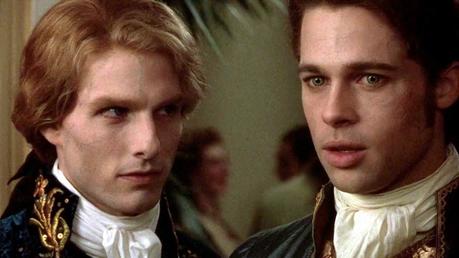
Louis de Point du Lac (Pitt) functions as the film's protagonist. He agrees to the titular interview with a present-day journalist (Christian Slater) to tell his life story. We first see him as a human in late 18 th century New Orleans, grieving the loss of his wife and child, throwing himself headlong into encounters he hopes will end in his death. Eventually, he finds himself at the fang-end of Lestat (Tom Cruise), who transforms him into the vampire we see before us. Conversion from a character who wants to die into a creature who is all but immortal feels like the ultimate in grim irony.
Sexuality has always been a subtextual component of the vampire myth. The transformation does boil down to fluid exchange, after all, but Interview with the Vampire turns that subtext into text. Lestat's attack on Louis feels like seduction, and their facial expressions portray sexual ecstasy. The relationship they develop feels like a marriage, right down to the eternal child (Kirsten Dunst) Lestat creates to prevent Louis from leaving him behind. Raising Claudia yields some of the film's only moments of comedy, as we watch Lestat and Louis raise a daughter who possesses a spoiled child's reckless impulsivity coupled with a killer's ruthlessness. Rather than scolding her for drawing on the walls, she's rebuked when she drains her seamstress or a particularly stern piano teacher.
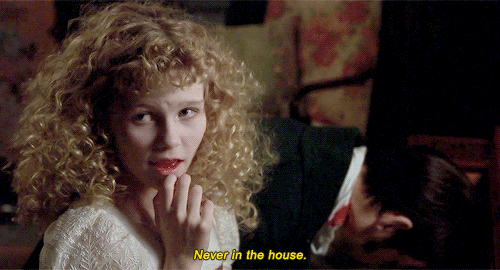
She exists as a child who does not need permission to buy a doll. She can simply murder the doll-maker and leave with it in hand. The strange coupling of domesticity with homicidal instincts results in the film's few laughs, because the rest of the story plays as operatic tragedy. Although, I'd be remiss if I didn't mention the rather hilarious shot of a contemporary Louis leaving a screening of Tequila Sunrise, a film I can only assume he saw because he believed it to be all about sunrises. It's a quick sight gag, but I always smile at it.
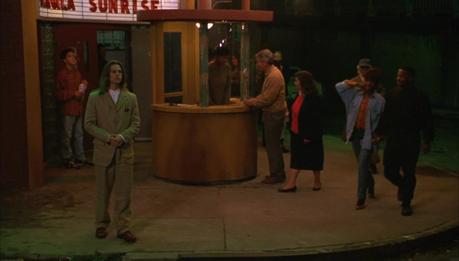
If Interview has an inherent flaw, it's that it's a film in which not very much happens. There's an underlying tension between an old-world outlook and the need to adapt to more modern times. Louis seems to survive because he's never really felt at peace no matter the era, while we see Lestat struggle once the era of the Libertine passes. Even Armande (Antonio Banderas, who might be one pretty man too many), another vampire who drifts in and out of Louis's world, sees him as a means to adapt to a new age, but the film isn't really about that.
Instead, it's a tale of watching the world spin forward and the pain that accompanies longevity. Much of that stems from having Louis as its protagonist, as he operates as passivity personified. He takes very little action until nearly the film's end, when a betrayal forces a vengeful act but prefers to lamenting and observing rather than action. The film's most dynamic characters, Lestat and Claudia, are sadly more sporadic within the narrative.
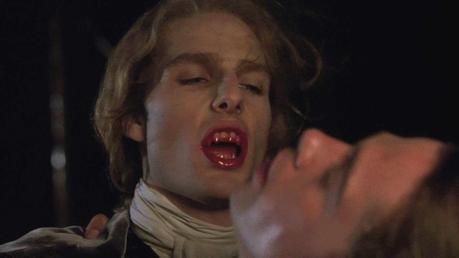
Lestat is as close to a punk rock vampire as Anne Rice's world allows, and it's funny to see the roots of a vampire dynamic that now feels so commonplace. When there are two, particularly male, vampires, one will be a brooding brunette, while the other will be a carefree, unapologetic blonde. That's a trend that has its origins in the Louis and Lestat dynamic and continued on into both Buffy's Angel and Spike and True Blood's Bill and Eric.
Anne Rice expressed some initial displeasure at Cruise's casting, feeling he was too all-American to play Lestat, but he provides the film with its liveliest performance, exuding an untamed sensuality he rarely gets to play, and Neil Jordan makes particularly effective use of the vaguely malicious glint often seen in Cruise's eyes.
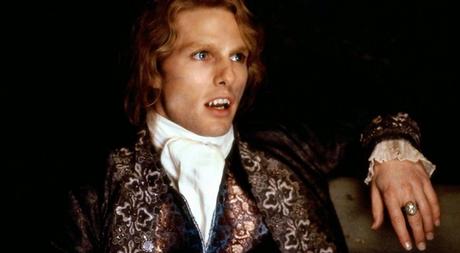
Pitt's Louis is left to brood and complain, then brood some more, and...little else. Pitt's effective, and I'm always a bit of a sucker for vampire rumination, but it's hard not to feel a certain sympathy when Lestat finally lets his frustration bubble to the surface, and yells, "Oh, shut up, Louis." Lestat may be a monster, but he's flashy and entertaining enough that you can't really despise him.
Kirsten Dunst has the trickiest character to portray, a child who lives lifetimes but never ages. The film forces her to convey the wisdom and knowledge of one who mentally matures beyond her youthful appearance, and she does beautifully. She's an adult cursed to forever reside inside a young child's body, and her journey leads to the most devastating of outcomes.
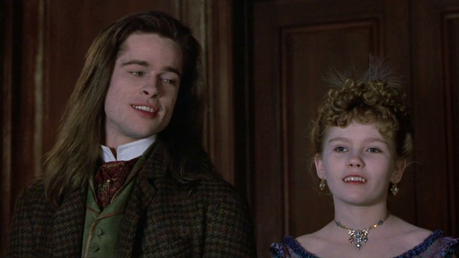
It's too Dunst's credit that we feel for Claudia, who is at her core an unremorseful killer full of fury resentment, but she's been forced into a life she didn't choose and is powerless to escape. She becomes the film's deadliest schemer, ultimately retaliating against Lestat in a way Louis can never muster, torpedoing their little makeshift family in a moment of calculating cruelty.
Upon its release, the film's violence found itself at the center of discussion. Oprah Winfrey infamously walked out of a screening after just 10 minutes. By the end of 1994, Interview with the Vampire, Pulp Fiction, and Natural Born Killers became reference points for arguments of Hollywood abandoning all pretense of common decency. Granted, Interview 's inclusion might just as well be attributed to its homoerotic undertones for as much as its violence, but its unromanticized scenes of bloodletting turned stomachs. However, more than twenty years removed the film's gore now seems downright restrained.
There are scenes of rats and dogs being fed upon and brief moments of horrific violence, such as the moment Lestat appears to kiss a young woman's breast, only to pull away and reveal blood saturating her white clothes. Her rapturous look giving way to gradual, dawning terror makes the scene feel more upsetting than its minimal gore. He then slices her wrist, drains it into a goblet, and tosses her in a coffin, a scene that feels horrific due to its casual cruelty rather than its viscera.
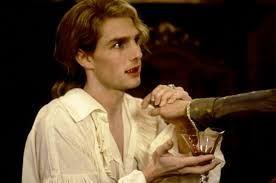
Much of the violence is filmed with a kind of intimacy and close-ups on individual's faces as the life drains from them, which makes the carnage feel more distressing that it would if filmed in an impersonal light.
The violence Lestat and other characters inflicts feels grim and intimate, even shocking, but never graphic or gratuitous. The film isn't really about the violence. That's simply a fundamental aspect of their existences. Instead, it chooses to focus on the burden of living such a life. It's probably as close to reality as a vampire's narrative of an outsider's life as possible. Neil Jordan's direction and Anne Rice's screenplay takes an absurd premise and takes it seriously, emphasizing the inherent pathos of its characters' existences.
Beyond that, the film looks beautiful. Full of lush reds and golds, as well as inky black nights and slithering, silver fogs, it's a sensual feast, that kicks into overload when Louis and Claudia arrive in Paris. They find themselves at the Theatre des Vampires, a Grande Guignol theatre troupe, living in pod-like catacombs beneath a theatre, where vampires pretend to be humans pretending to be vampires. They present plays steeped in vivid, haunting imagery, climaxing with a woman who is stripped nude, lowered to the ground, and fed upon like carrion. It's an image both chilling and gorgeously rendered, and those descriptives could be used for much of the film.
Even with minimal action to keep the account moving forward, it kind of doesn't matter. Interview with the Vampire thrives on its visceral energy and tantalizes with its moody exterior, gorgeous gothic imagery, and committed performances. Despite its inherent melancholy and gloom, when the interview wraps and the reporter encounters a familiar, hungry passenger in his backseat, it's possible to watch the closing credits feeling charged and humming along to "Sympathy for the Devil."
Here's What Else We've Watched So Far:Tomorrow: Kelly picks his favorite horror movie

